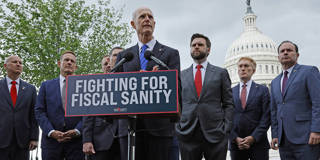The United States’ debt-to-GDP ratio, which improved during the inflationary spike of 2021-22, is expected to increase as inflation cools and the US population rapidly ages. While ultra-conservative Republicans advocate cutting non-defense discretionary spending to restore debt sustainability, the numbers do not add up.
CAMBRIDGE – The long-term sustainability of the United States’ government debt is back in the spotlight. The cause is not the manufactured debt-ceiling crisis, which was resolved at the end of May, just days before the US Treasury ran out of money. Instead, the impetus behind this renewed scrutiny is the rapid rise in interest rates over the past year.
As long as interest rates, both nominal and real, remained at near-zero levels, the federal government could keep borrowing. But the surge in interest payments on the US national debt and the expectation of further increases in 2023 and 2024 has become a powerful constraint on fiscal policy. While the inflationary spike of 2021-22 has improved the US debt-to-GDP ratio, real interest payments on the national debt are set to rise, now that inflation is cooling.
Broadly speaking, prudent fiscal policy rests on two guiding principles. First, it should be countercyclical: policymakers should increase spending (or cut taxes) to stimulate the economy in response to recessions, and they should restrict spending (or raise taxes) in response to booms. The second principle emphasizes long-term sustainability: debt should grow at a slower pace than the economy so that the debt-to-GDP ratio declines.

CAMBRIDGE – The long-term sustainability of the United States’ government debt is back in the spotlight. The cause is not the manufactured debt-ceiling crisis, which was resolved at the end of May, just days before the US Treasury ran out of money. Instead, the impetus behind this renewed scrutiny is the rapid rise in interest rates over the past year.
As long as interest rates, both nominal and real, remained at near-zero levels, the federal government could keep borrowing. But the surge in interest payments on the US national debt and the expectation of further increases in 2023 and 2024 has become a powerful constraint on fiscal policy. While the inflationary spike of 2021-22 has improved the US debt-to-GDP ratio, real interest payments on the national debt are set to rise, now that inflation is cooling.
Broadly speaking, prudent fiscal policy rests on two guiding principles. First, it should be countercyclical: policymakers should increase spending (or cut taxes) to stimulate the economy in response to recessions, and they should restrict spending (or raise taxes) in response to booms. The second principle emphasizes long-term sustainability: debt should grow at a slower pace than the economy so that the debt-to-GDP ratio declines.